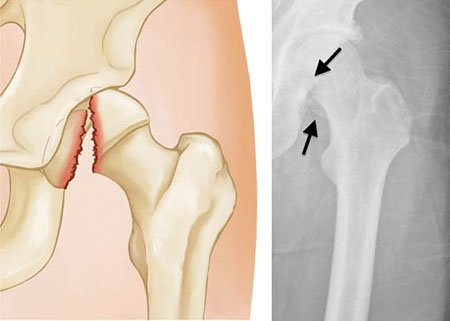A nurse is caring for an older adult client who had a femoral head fracture 24 hours ago and is in skin traction. The client reports shortness of breath and dyspnea. The nurse should suspect that the client has developed which of the following complications?
Pneumothorax
Pneumonia
Airway obstruction
Fat embolism
The Correct Answer is D
Choice A reason:
Pneumothorax, a collapsed lung, can indeed cause shortness of breath and dyspnea. However, it is typically associated with a sudden onset of these symptoms following a chest injury or spontaneously in the case of a ruptured air blister. In the context of a femoral head fracture, pneumothorax is less likely unless there was additional trauma to the chest area.
Choice B reason:
Pneumonia is an infection of the lungs that leads to inflammation of the air sacs, causing them to fill with fluid or pus. Symptoms include cough with phlegm, fever, chills, and difficulty breathing. While pneumonia could cause dyspnea, it usually develops due to an infectious process rather than directly from a femoral head fracture.
Choice C reason:
Airway obstruction involves a blockage that prevents air from passing freely to the lungs. It can be caused by foreign objects, swelling due to allergic reactions, or other medical conditions. The symptoms of airway obstruction include difficulty breathing, wheezing, and potential changes in skin color. However, airway obstruction is not commonly a direct complication of a femoral head fracture.
Choice D reason:
Fat embolism syndrome is a serious condition that occurs when fat globules enter the bloodstream and lodge within the pulmonary vasculature, leading to respiratory distress. It is a known complication following long bone fractures, such as the femur, and presents with symptoms like shortness of breath, hypoxemia, and neurological manifestations. Given the recent femoral head fracture and the symptoms reported, fat embolism syndrome is the most likely diagnosis.

Nursing Test Bank
Naxlex Comprehensive Predictor Exams
Related Questions
Correct Answer is D
Explanation
Choice A reason:
Ecchymosis, or bruising, of the surrounding skin is a common finding associated with fractures due to the trauma to blood vessels in the area. While it can indicate bleeding or injury, ecchymosis itself does not specifically indicate impaired venous return.
Choice B reason:
Acute pain is a typical symptom following a fracture and results from the injury to the bone and surrounding tissues. Pain is an expected finding and does not directly suggest an issue with venous return.
Choice C reason:
A bounding distal pulse may actually suggest increased arterial flow or could be a sign of other conditions such as high blood pressure or fever. It does not indicate impaired venous return, which is typically characterized by a lack of pulse or a very weak pulse.
Choice D reason:
Increasing edema, or swelling, in the affected arm is a sign of impaired venous return. When veins are unable to effectively return blood to the heart, fluid can accumulate in the tissues, leading to edema. In the context of a fracture, this could be due to compression or damage to the veins, which can impede blood flow and result in swelling.
Correct Answer is ["B","C","E"]
Explanation
Choice A reason:
Increased hematocrit levels are not typically associated with fluid overload. In fact, hematocrit may decrease in fluid overload due to hemodilution, where the volume of plasma increases, diluting the concentration of red blood cells.
Choice B reason:
An increased respiratory rate can be a sign of fluid overload. As fluid accumulates in the body, it can lead to pulmonary edema, which is the buildup of fluid in the lung's air sacs. This can impair gas exchange and lead to increased respiratory rate as the body attempts to compensate for reduced oxygenation.
Choice C reason:
Increased blood pressure is a common finding in fluid overload. As the volume of fluid in the bloodstream increases, it can lead to higher blood pressure due to the extra fluid that the heart must pump and the increased resistance in the blood vessels.
Choice D reason:
Increased temperature is not a direct finding associated with fluid overload. While fever may indicate an infection or other conditions, it is not specifically related to the volume of fluid in the body.
Choice E reason:
An increased heart rate may occur in fluid overload as the heart works harder to pump the excess volume of blood through the body. This compensatory mechanism aims to maintain adequate circulation and blood pressure despite the increased fluid volume.
Whether you are a student looking to ace your exams or a practicing nurse seeking to enhance your expertise , our nursing education contents will empower you with the confidence and competence to make a difference in the lives of patients and become a respected leader in the healthcare field.
Visit Naxlex, invest in your future and unlock endless possibilities with our unparalleled nursing education contents today
Report Wrong Answer on the Current Question
Do you disagree with the answer? If yes, what is your expected answer? Explain.
Kindly be descriptive with the issue you are facing.
